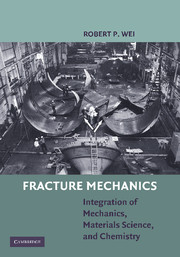Book contents
- Frontmatter
- Contents
- Preface
- Acknowledgments
- 1 Introduction
- 2 Physical Basis of Fracture Mechanics
- 3 Stress Analysis of Cracks
- 4 Experimental Determination of Fracture Toughness
- 5 Fracture Considerations for Design (Safety)
- 6 Subcritical Crack Growth: Creep-Controlled Crack Growth
- 7 Subcritical Crack Growth: Stress Corrosion Cracking and Fatigue Crack Growth (Phenomenology)
- 8 Subcritical Crack Growth: Environmentally Enhanced Crack Growth under Sustained Loads (or Stress Corrosion Cracking)
- 9 Subcritical Crack Growth: Environmentally Assisted Fatigue Crack Growth (or Corrosion Fatigue)
- 10 Science-Based Probability Modeling and Life Cycle Engineering and Management
- APPENDIX: Publications by R. P. Wei and Colleagues
- References
9 - Subcritical Crack Growth: Environmentally Assisted Fatigue Crack Growth (or Corrosion Fatigue)
Published online by Cambridge University Press: 05 June 2012
- Frontmatter
- Contents
- Preface
- Acknowledgments
- 1 Introduction
- 2 Physical Basis of Fracture Mechanics
- 3 Stress Analysis of Cracks
- 4 Experimental Determination of Fracture Toughness
- 5 Fracture Considerations for Design (Safety)
- 6 Subcritical Crack Growth: Creep-Controlled Crack Growth
- 7 Subcritical Crack Growth: Stress Corrosion Cracking and Fatigue Crack Growth (Phenomenology)
- 8 Subcritical Crack Growth: Environmentally Enhanced Crack Growth under Sustained Loads (or Stress Corrosion Cracking)
- 9 Subcritical Crack Growth: Environmentally Assisted Fatigue Crack Growth (or Corrosion Fatigue)
- 10 Science-Based Probability Modeling and Life Cycle Engineering and Management
- APPENDIX: Publications by R. P. Wei and Colleagues
- References
Summary
Overview
In Chapter 8, the essential framework and methodology for quantifying the influences of environment on crack growth was described. Here, environmentally assisted fatigue crack growth (or corrosion fatigue) in gaseous and aqueous environments, and its conjoint action with stress corrosion cracking, are considered. Illustrations (constrained by the “windows of opportunity” to a large extent) are drawn from research in the author's laboratory, and will highlight aluminum alloys, titanium alloys, and high-strength steels. The approach follows that used for stress corrosion cracking, and focuses on coordinated experiments and analyses that probe the underlying chemical, mechanical, and materials interactions for crack growth. Linkage of the fracture mechanics based approach to the traditional stress-life (S-N) approach is made to provide a “common basis” for the interpretation and utilization for fatigue data in design, and to address “key (physically based) sources” for variability in S-N data. The various processes, and their inter-relationships, are depicted in the schematic diagrams shown previously in Fig. 8.7. Their incorporation into models for fatigue crack growth, however, is different, and is presented in Section 9.2.
It should be noted that, in corrosion fatigue, manifestations of environmental effects are reflected in a frequency dependence that gives rise to increase in fatigue crack growth rate (per cycle) with decreasing loading frequency that cannot be attributed to concomitant stress corrosion cracking.
- Type
- Chapter
- Information
- Fracture MechanicsIntegration of Mechanics, Materials Science and Chemistry, pp. 158 - 182Publisher: Cambridge University PressPrint publication year: 2010



